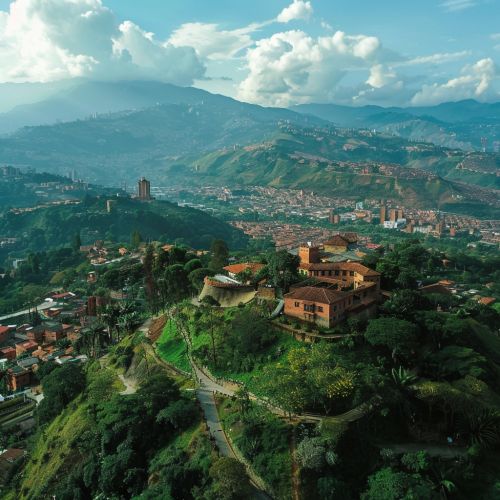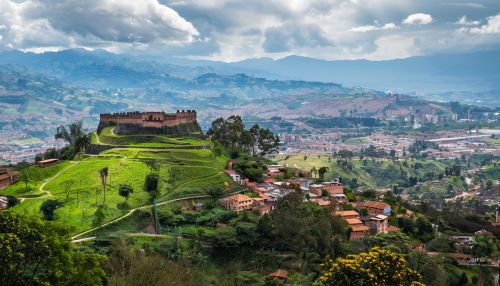Medellín, Spain
History
Medellín is a municipality located in the province of Badajoz, in the autonomous community of Extremadura, Spain. The town has a rich historical heritage that dates back to ancient times. The area was originally inhabited by the Celtiberians, an ancient Celtic people of the Iberian Peninsula. The town's name is derived from the Latin "Metellinum," named after the Roman general Quintus Caecilius Metellus Pius, who founded the town in the 1st century BC.
During the Roman period, Medellín was an important settlement due to its strategic location near the Guadiana River. The town flourished under Roman rule, becoming a significant center for trade and agriculture. Numerous archaeological remains, including a well-preserved Roman theater, attest to the town's historical significance during this era.
After the fall of the Roman Empire, Medellín experienced a period of decline. The Visigoths and later the Moors occupied the town, each leaving their mark on its cultural and architectural landscape. The Reconquista, the Christian reconquest of the Iberian Peninsula, brought Medellín back under Christian control in the 13th century. The town was granted to the Order of Santiago, a military order that played a crucial role in the Reconquista.
Medieval Period
In the medieval period, Medellín became a fortified town with the construction of a castle on a hill overlooking the town. The castle served as a defensive stronghold and a symbol of the town's strategic importance. The town's layout during this period was characterized by narrow, winding streets and fortified walls.
One of the most significant figures associated with Medellín is Hernán Cortés, the famous Spanish conquistador who led the expedition that resulted in the fall of the Aztec Empire. Cortés was born in Medellín in 1485, and his legacy is still evident in the town today. The house where he was born has been preserved and is a popular tourist attraction.
Modern Era
In the modern era, Medellín continued to develop as a rural town with a focus on agriculture. The town's economy has traditionally been based on the cultivation of cereals, olives, and grapes. In recent years, there has been a growing interest in tourism, with visitors attracted to the town's historical sites and scenic landscapes.


Geography
Medellín is situated in the central part of the province of Badajoz, within the autonomous community of Extremadura. The town is located on the banks of the Guadiana River, which has historically been a vital waterway for the region. The surrounding landscape is characterized by rolling hills, fertile plains, and a Mediterranean climate with hot summers and mild winters.
The town's geographical location has played a significant role in its historical development. The proximity to the Guadiana River provided a reliable water source for agriculture and facilitated trade and communication with other regions. The fertile soil in the area has made it an ideal location for the cultivation of various crops, including cereals, olives, and grapes.
Economy
The economy of Medellín has traditionally been based on agriculture. The fertile plains surrounding the town are well-suited for the cultivation of cereals, olives, and grapes. The town is known for its high-quality olive oil and wine, which are important products for the local economy.
In recent years, there has been a growing interest in tourism as a source of economic growth. The town's rich historical heritage, including the Roman theater and the castle, attracts visitors from around the world. Efforts have been made to promote Medellín as a tourist destination, with investments in infrastructure and the preservation of historical sites.
Culture
Medellín has a rich cultural heritage that reflects its long and varied history. The town is home to several important historical sites, including the Roman theater, the castle, and the house where Hernán Cortés was born. These sites are popular attractions for visitors and play a significant role in the town's cultural identity.
The town also hosts several annual festivals and events that celebrate its history and traditions. One of the most important events is the Festival of Santiago, held in honor of the town's patron saint, Santiago (St. James). The festival includes religious processions, traditional music and dance, and various cultural activities.
Architecture
Medellín's architectural heritage is a testament to its long and varied history. The town is home to several important historical buildings and structures, including:
Roman Theater
The Roman theater in Medellín is one of the best-preserved examples of Roman architecture in Spain. The theater was built in the 1st century AD and could accommodate up to 3,000 spectators. It was used for various public performances, including plays, musical performances, and gladiatorial contests. The theater has been extensively restored and is now a popular tourist attraction.
Medellín Castle
The castle of Medellín is a medieval fortress that was built on a hill overlooking the town. The castle was constructed in the 13th century by the Order of Santiago and served as a defensive stronghold. The castle's strategic location provided a commanding view of the surrounding landscape and the Guadiana River. The castle has been partially restored and is open to the public.
Church of Santiago
The Church of Santiago is one of the most important religious buildings in Medellín. The church was built in the 13th century and is dedicated to St. James, the town's patron saint. The church features a mix of architectural styles, including Romanesque and Gothic elements. The interior of the church is adorned with beautiful frescoes and religious artifacts.
Education
Education in Medellín is provided by a combination of public and private institutions. The town has several primary and secondary schools that offer a comprehensive education to local students. In addition to traditional academic subjects, the schools also emphasize the importance of cultural and historical education, reflecting the town's rich heritage.
There are also opportunities for higher education in the nearby city of Badajoz, which is home to the University of Extremadura. The university offers a wide range of undergraduate and postgraduate programs and is an important center for research and innovation in the region.
Transportation
Medellín is well-connected to other parts of Spain through a network of roads and highways. The town is located near the A-5 motorway, which provides easy access to major cities such as Madrid and Lisbon. There are also regular bus services that connect Medellín to nearby towns and cities.
The nearest airport is located in Badajoz, approximately 50 kilometers from Medellín. The airport offers domestic flights to major Spanish cities, as well as some international destinations. For longer journeys, residents and visitors can also use the high-speed train services available in nearby cities.
Demographics
As of the latest census, Medellín has a population of approximately 2,500 residents. The town has experienced a gradual decline in population over the past few decades, a trend that is common in many rural areas of Spain. The population is predominantly Spanish, with a small number of foreign residents.
The demographic profile of Medellín reflects the town's rural character, with a higher proportion of older residents compared to urban areas. The town has a close-knit community, with many families having lived in the area for generations.
Notable Figures
Medellín is perhaps best known as the birthplace of Hernán Cortés, the Spanish conquistador who led the expedition that resulted in the fall of the Aztec Empire. Cortés was born in Medellín in 1485 and spent his early years in the town before embarking on his journey to the New World. His legacy is still evident in the town today, with several monuments and sites dedicated to his memory.
Another notable figure associated with Medellín is Pedro de Valdivia, a Spanish conquistador who played a key role in the conquest of Chile. Valdivia was born in Medellín in 1497 and is remembered for his contributions to the Spanish colonization of South America.
See Also
- Roman Theater
- Hernán Cortés
- Guadiana River
- Order of Santiago
- Reconquista
- Pedro de Valdivia
- Badajoz
- University of Extremadura
